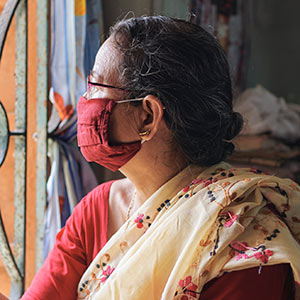
While many in the United States are starting to see a light at the end of the COVID-19 tunnel, India has been plunged into a new virus crisis, with diamond areas like Mumbai and Surat among those getting hit.
According to an April 27 report in MIT Technology Review, India is battling “one of the most acute COVID-19 crises any country has experienced yet.
“The country set a global record for new cases for the fifth day in a row yesterday, reporting 352,991 [cases] and 2,812 deaths. The true figure is almost certainly far higher. Modeling by researchers from the University of Washington’s Institute for Health Metrics and Evaluation suggests the true figure for new daily cases in India is likely to now number in the millions.”
Indian industry workers tell JCK that the business has not closed down, certainly not in the way it did last March. However, there are beefed-up precautions, and a feeling of unease in the air.
Rahul Jauhari, senior vice president, global sales and marketing, for Star Rays, predicts that Indian diamond production will likely decline about 10 to 15% over the next month—due to some workers calling in sick and others returning to their home villages—but cautions that it’s still early to say. (In fact, just about everyone JCK spoke to pegged the likely production drop-off to around 10 to 20%.)
Jauhari notes that since public transportation has largely halted, companies have had to send workers to factories in buses. However, customs is still working smoothly, and air cargo flights continue to take off.
Veteran analyst Pranay Narvekar, head of Pharos Beam Consulting, says that Mumbai is just emerging from a 10-day lockdown, which will hopefully contain the disease’s spread. But he doesn’t see much impact on the overall industry.
“It’s possible diamond production might slow, but even in a normal situation, May and June are quiet,” he says. “From July onward, things might get tight in terms of stock. But the stock levels have been above what they were last March before COVID hit. There was a serious risk of overproduction. This will cool it down a bit.”
He says one of the biggest problems now is a backlog at the GIA lab, which has also been operating at reduced capacity.
But that backlog is also a reflection of strong demand.
Ghanshyam Dholakia, founder and managing director of Hari Krishna Exports, says the continued worldwide hunger for diamonds is the silver lining to this situation.
“People are avoiding unnecessarily going out—meaning no shopping, no restaurants, no tourism,” he says. “But fortunately, it is not the case with the diamond industry.… The United States and China have good demand for diamonds. That has helped to recover exports in the last few months.”
Colin Shah, chairman of the Gem and Jewellery Export Promotion Council (GJEPC), the industry group, says that “if all goes well, there is going to be shortage of few items if manufacturing stays at lower levels in May and June. If, as expected, we see a COVID recovery towards the end of May, things will be okay for the industry.”
In the meantime, the GJEPC has asked the government to provide relief to affected workers and employers.
“It is time to support each other and work together to prevail amid the second wave of COVID,” he says.
Shah notes that the current circumstances has made the industry recommit to strict precautions. Workers are tested regularly, and the Bharat Diamond Bourse has restricted occupancy.
Dholakia is hopeful that the increased adherence to safety guides, and wider availability of vaccines, will soon bring things back to normal. He also feels that “India has been more highlighted in the news just because there is a vast population.”
Still, the situation has taken a toll.
“This seems to be a much more virulent strain with faster spread,” says Narvekar. “The health care system has problems and it’s struggling to keep up.”
In a change from what countries like the United States have experienced, this latest spread seems to be hurting mostly the middle and upper classes.
“In the slums you can’t socially distance,” Narvekar says. “People have already gotten it in their systems and are exposed to much more virus and germ activity. They are still okay. It’s the middle class that is getting hit.”
What’s particularly frustrating is that, just a few months ago, it looked like India had the virus whipped.
“In January, everything was back to normal,” says Jauhari. “We were living a normal life. And then, in mid-March, all of a sudden things just started to explode.”
Tarang Parikh, general manager at Craftarena Jewels, which sells lab-grown diamonds, feels that large gatherings and a loosening of precautions led to the current outbreak. Now, people are more careful.
The international community has shown support, with even longtime rival Pakistan offering assistance.
U.S. President Joe Biden says America is determined to help.
“Just as India sent assistance to the United States as our hospitals were strained early in the pandemic,” he tweeted, “we are determined to help India in its time of need.”
Parikh hopes crises like this will help us all to recognize our common humanity.
“We all are separated by borders, but still we all are humans,” he says. “Be kind to each other.”
This story has been updated with comments from Colin Shah.
(Photo: Getty)
- Subscribe to the JCK News Daily
- Subscribe to the JCK Special Report
- Follow JCK on Instagram: @jckmagazine
- Follow JCK on X: @jckmagazine
- Follow JCK on Facebook: @jckmagazine






